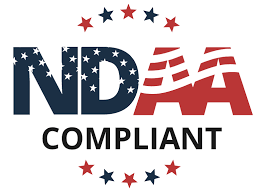
By Jay Jason Bartlett
A crucial piece of legislation that establishes the Department of Defense’s (DoD) budget and policies is the National Defense Authorization Act (NDAA) of the United States. The DoD and other federal agencies’ use of video surveillance camera equipment is a crucial component of the NDAA. Concerns regarding the potential use of surveillance technology by foreign adversaries have risen in recent years. The NDAA specifies rules for the DoD and other agencies’ use of surveillance technology, as well as requirements for the use of surveillance technology by foreign corporations.
The DoD and other agencies are allowed to use surveillance camera technology, according to a number of NDAA requirements. The Federal Information Processing Standards (FIPS) 140-2 must be followed by any surveillance camera equipment utilized by these organizations. This is one of the most crucial requirements. This standard specifies the specifications for the cryptographic components used in security systems, such as the hardware for video surveillance cameras. The NDAA ensures the security and resilience of the video surveillance camera equipment used by the DoD and other agencies by requiring compliance with this standard.
The NDAA’s demand that the DoD analyze all video surveillance camera equipment employed by the organization in order to find any potential security flaws is another significant clause. This analysis is essential to finding any surveillance system flaws that potential adversaries from abroad might try to use against us. The DoD must create and carry out a strategy to remediate any discovered security vulnerabilities, according to the NDAA.
The NDAA includes explicit provisions about the use of surveillance technology by foreign adversaries in addition to these provisions relating to the use of surveillance camera equipment by the DoD and other agencies. One of these clauses calls for the DoD to compile a list of foreign organizations that could jeopardize national security by acquiring or employing surveillance equipment. Each year, a new version of this list must be submitted to Congress.
The NDAA forbids foreign organizations from using specific surveillance technology. The act specifically forbids the use of video surveillance camera technology produced by specific Chinese firms, such as Hikvision and Dahua. Due to their strong ties to the Chinese government, these businesses have been classified as being a risk to national security.
The DoD must create a strategy for identifying and reacting to any improper use of surveillance technologies by foreign actors, according to the NDAA. This strategy must contain methods for spotting and disclosing any such conduct, as well as steps to lessen its effects.
Overall, the NDAA contains a number of significant provisions pertaining to the DoD’s and other government agencies’ use of video surveillance camera equipment as well as foreign
corporations’ use of surveillance technology. The security and protection of the United States from potential dangers depends on these provisions. The NDAA aids in ensuring the security and dependability of the surveillance camera equipment used by the DoD and other agencies by enforcing adherence to stringent security requirements and creating strategies to remediate any weaknesses. The NDAA also aids in protecting against possible risks to national security by outlawing the use of surveillance technology by specific foreign entities and creating strategies to identify and address unlawful use of such technology.
There are worries that the NDAA’s provisions for standards and protections regarding the use of technology and surveillance camera equipment may not go far enough. The use of surveillance camera equipment, according to some experts, should be subject to even stronger regulations in the NDAA, especially in light of the growing technological sophistication of opponents from abroad. Furthermore, there are worries that certain foreign organizations could be able to get around the NDAA’s restrictions by buying surveillance equipment from outside sources.
The NDAA continues to be a crucial piece of legislation for guaranteeing the safety and protection of the United States notwithstanding these worries.

Jay Jason Bartlett is the Managing Editor of Security.World and the CEO of Cozaint Corporation, a manufacturer of security surveillance solutions. Jay has over 40 years in the high-tech industry and over 15 years in physical security. visit: cozaint.com
See more articles by: Jay Jason Bartlett
Source: cozaint.com
